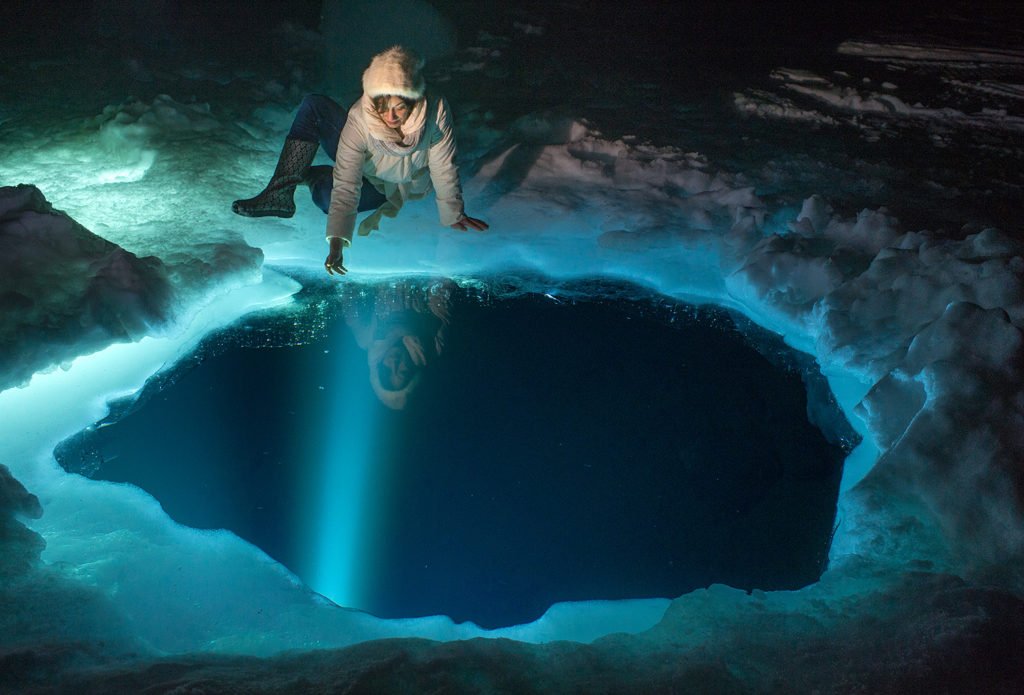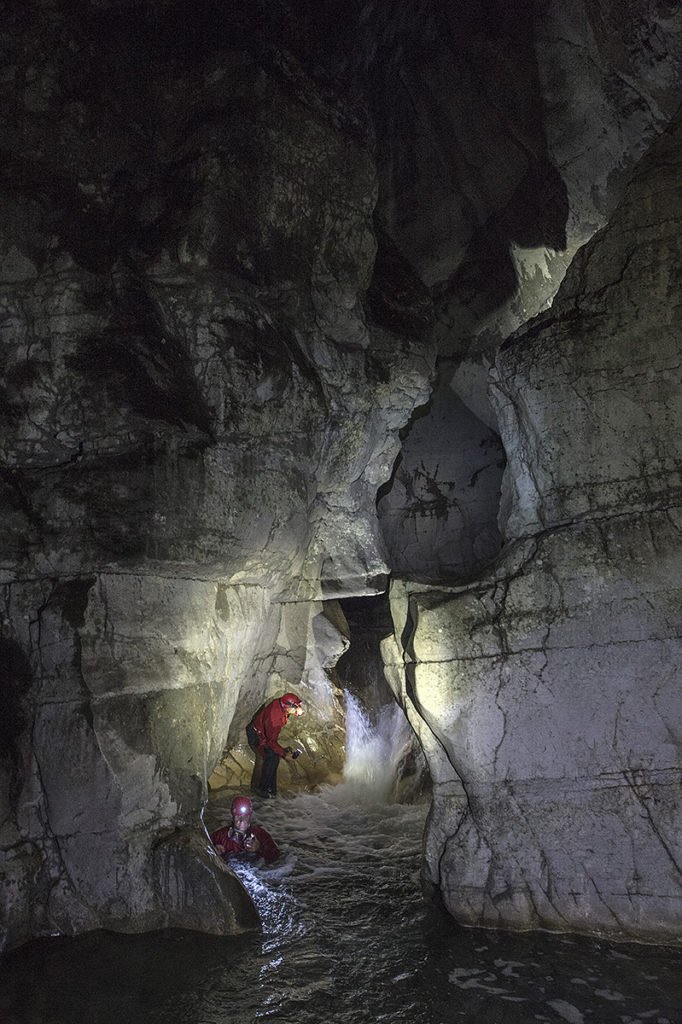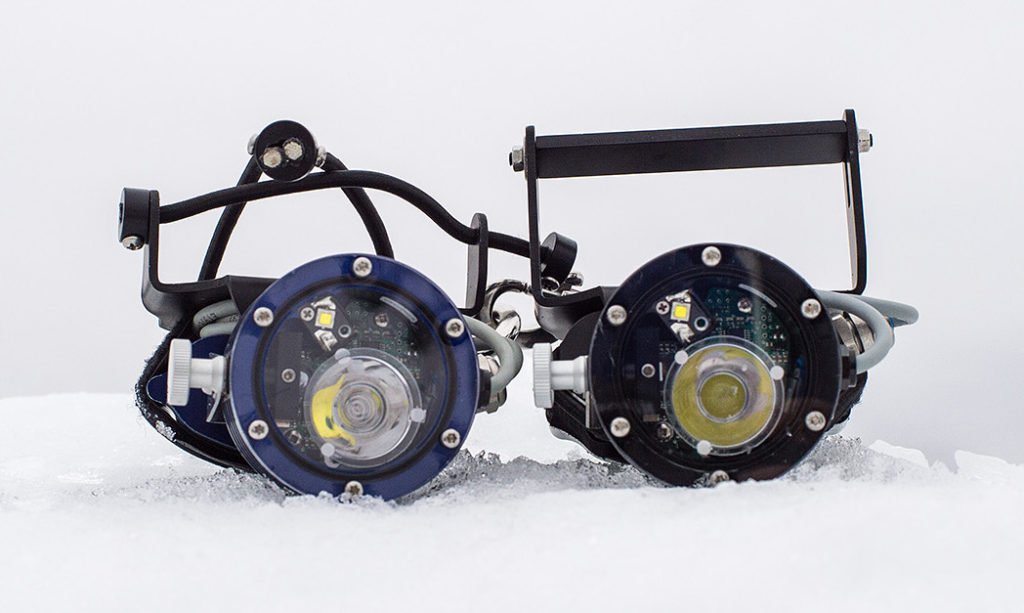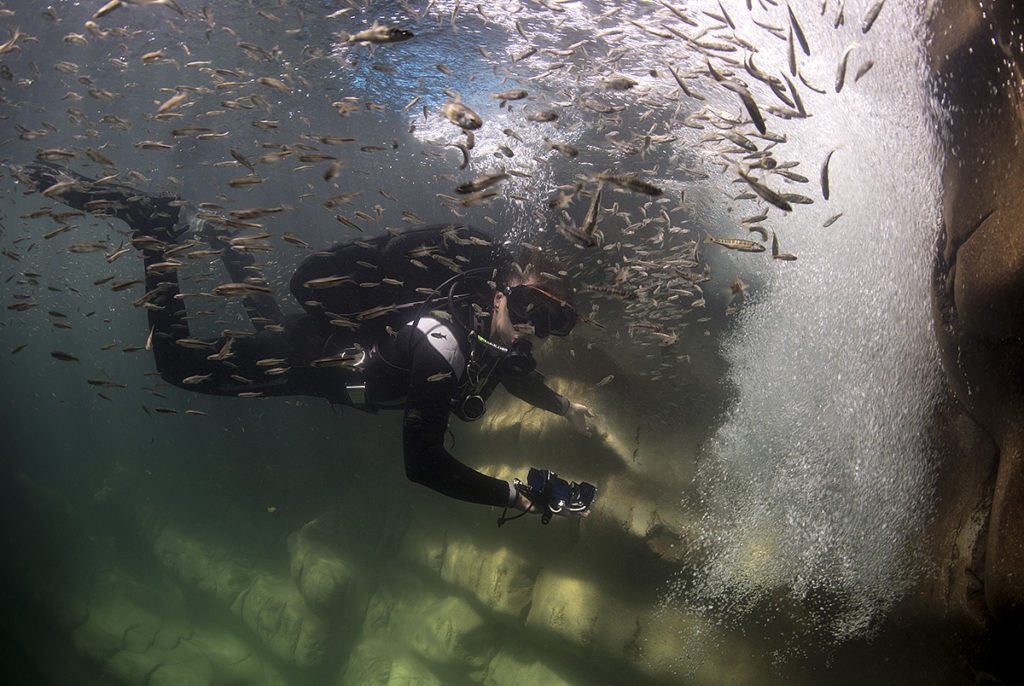I want to tell you about the light we have been using for two years. This is a cave light created by Swiss cavers. Scurion designed to work both on land and under water, it has a capacious battery, the light head and canister battery are separable, canister has a slightly curved shape. Thus, the battery can be placed on the belt of diving harness or between tanks, mounted on a helmet or on the climbing harness and lamp head could be worn on the hand in Goodman-style, or mounted on a helmet. By the way, the Swiss do wire of any length according to your desire. But in most cases, under the water, we did not separated canister and the head, as in the water all this stuff has neutral buoyancy.
There are “parking” mode to prevent accidental switching, a temperature sensor, so that even if you forget to lock it, and it switched on in your luggage, nothing bad will happen.
The battery is small in size, but capacious, the light shines even at full power for about 3 hours, but in the dim light the time tends to infinity. Of course, I am kidding. According to the technical description it is about 106 hours.
The lamp has two elements inside, to offer a wide and narrow beam, both elements have five stages for power adjustment: from 0 to 4. There is also a sensor of discharge of the battery level.
This is a light for those who love the construction toys and other complicated things, as its head is really smart, unlike many divers are. It remembers combinations of light: from 3 to 10. For example, a narrow strong at full capacity and wide at 0, narrow and wide at full capacity, a weakest wide (camp economical option), etc. This is handy if you imagine your dive conditions, for example, you’ll need a medium broad and narrow to reach the water; the most powerful wide to assemble the equipment; if next you dive in clear water you will switch both elements at full capacity, narrow and wide. You can reprogram the lamp along the way, if the conditions changed, but in the water under stress it is not very convenient, it is better to prepare in advance. Modes are changed by turning a single switch (such Apple among lamps).
We’ve used these lights for photo and video shooting, including the project #Seagull which had been shot with these lights.

The #Seagull Project. We have tied together two Scurion lamps at full power and lowered into the water to make ice and an ice hole glow from within.
Everybody asks how powerful they are, but it is difficult to estimate, because LED-lamps are characterised by a luminous flux. According to technical characteristics of Scurion 1500 (those that we have), it produces 1300 lumens, in terms of HID, we rated it as about 20 watts. The temperature of the light can be selected at purchase: 6000K or 3000K.
I worried a little about the fact that the lamp head has unprotected glass edges, and can be scratched and chipped off from hitting the walls of the cave. Those who go to the caves, knows that in tight passages you regularly touch the walls with the helmet. I asked the producer, don’t he consider to protect the edges of the glass with a rubber or metal strip. He replied that it is not necessary, since even the most careless cavers use glass for a long time, it is not vulnerable, and small scratches do not affect and change of the glass worth just a couple of euros.
I hesitated, but really – we use them for two years, but nothing critical happened.

Okatse canyon pioneers Amiran Dzhamrishvili Valery Barbaqadze, Gigo Oniani. The whole scene is illuminated with 3 Scurions.
The battery canister is made of aluminium, the cower is screwed with two bolts. Usually we change the battery elements in a warm dry room, and it is OK. I’m not sure is it comfortable to change the batteries in the cave, when clay is everywhere: on the hands and on the canister as well. What if it falls on o-ring, and the canister will leak? I don’t know. By the way, for the cave use: it is recommended to attach the cover with a special wire, which comes in repair kit together with o-rings and additional bolts. By the way, it is not recommended to screw up bolts with all the dope, for aluminium is a soft metal, and there is the risk to strip the thread. It is not necessary to close tightly because the water pressure will squeeze the cover.
It relies to criticize at the point. It seems for underwater video the wide beam angle is not sufficient, and even two lamps cannot uniformly illuminate a scene. For the #Seagull we should light not all the scene, but only focus on Natasha’s figure, so these lights fitted perfectly.
In the warm Georgian caves Scurions overheated sometimes at full power, and reduced the power (Did I say they are fucking smart?) The lamp head can be cooled with water. Or one may buy and add extra heat sink.
Here is another intelligent feature: when battery is low, the lamp blinks twice, warning, and reduces the power. For the video or photo lighting set it is a little annoying. But if you think about saving the power during long travel into a cave, it is a very important feature. And in the case of completely low battery the lamp switches off lights at all, for not to starve to death the charging element and spoil it.

Bogdana Vashchenko with 2 Scurions lights the painting by artist Denis Lotarev, who draws the portrait of Seagull (Natalie Avseenko)
Here is another intelligent feature: when battery is low, the lamp blinks twice, warning, and reduces the power. For the video or photo lighting set it is a little annoying. But if you think about saving the power during long travel into a cave, it is a very important feature. And in the case of completely low battery the lamp switches off lights at all, for not to starve to death the charging element and spoil it.
Another small detail: for photos we often use a torch as a pointer when the beam illuminates something important, creates focus. With Scurions we were not able to do like that, because the lamp glass gives side illumination, and in the photo it turns to be ugly overexposed spot. The problem had been fixed with a couple of turns of electrical tape around the lamp’s perimeter (here is the protection of glass from impacts, in combination :)).
Initially the lamp had been created as a pure cave lamp, and the manufacturer pointed out for a long time that it is not a full-fledged underwater light, but we used it in the canyons of Georgia, under the ice of Lazurny Quarry, during expedition to the Baikal lake, we dived with these lights up to 40-50 meters (it is certified to do 150m). It works fine without any complaints. So this device deserves an excellent grade. And the price for it is quite reasonable: in the most high-end extent of delivery it costs less than 1,000 euros.


